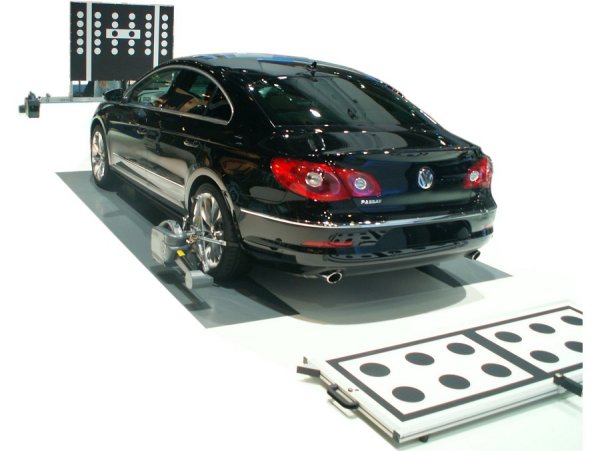Axle Alignment


The advice, in the case of axle alignment, not to rely totally only on the pure measurement values, but also to consider the visual examination, your impression and theapplication of a sound knowledge of the various suspension types to find the error, should be the procedure used in all vehicle-areas.
Nevertheless, problems with the suspension have the effect of permanently disturbing the driving pleasure. Apart from that, they are difficult to pin-point using testing devices,searching for the error by computer seldom brings the required results, over and above this, the problem is difficult to check by, e.g., test driving the vehicle. Therefore, it iswise to protect the suspension by adopting a considerate driving manner and not to provoke trouble by mounting add-ons from uncertain sources.
Sometimes the preparation for testing is more complex than actual implementation. Of course, directly before the aligning, the vehicle springs should not be expanded. Shouldrespective work have been carried out, please do a thorough test drive. By the way, in the following text we are assuming problems, which cannot be solved by a standard axlealignment.
Then, we have a very good look at the tyres. We check the air-pressure and the road-contact surface. Here you can read up on the problems which can appear and how theyare to be interpreted. Very often overlooked, is the comparing of the measurements of the individual tyres and rims, inluding the apparently unimportant depth of the rim-bowl. Ifthere is any suspicion at all, that the rims are not standard, check the stud-hole pattern and the centering.
Now you can examine the suspension itself. This includes the guides, their structural joints and the rubber mountings. At this point there should be a tyre-lever at hand, to beable to apply enough force to change the position of a mounting. Any play at all here, is absolutely not permitted. In there steering, or the wheel bearings, a very small amountof play, or none at all is permitted.
In this situation the shock absorbers can only be visually checked, whereby, a very small amount of oil-loss can be tolerated. Should the vehicle be in the correct position forthe aligning, the use of weights is very important. Ideally, they are to be placed in such a way as to simulate the normal use of the vehicle, in doing so, the problem(s) arenoticed sooner. In this case, it is helpful to ask the customer how the vehicle is generally used.
The operating instructions of the tester describe the remaining preparation work. Of course, we assume that the testing surface is level and horizontal. Should the testingdevice suggest, before we start, a compensation by rolling the vehicle forwards or backwards, this should be done just as conscientiously as the reading out of the values later.Also, in this respect, modern testing devices will not tolerate slovenliness.
The display showing the track can be used to check the center position of the steering wheel. Any repairing here, e.g., by laymen, is prevented by the fact that one often hasno idea how the airbag works. Should the track- and camber values be correct, and if the tyre-wear pattern also shows no abnormalities, the problem can be more easilylocalised. If the values are not conform, either the settings can be changed, or, if they're not available, the respective part can be replaced.
In the event that no problem has appeared up to now, the caster and the splaying of the wheel position when cornering, are to be checked on the test bench. Should this bethe reason why the customer is not satisfied, in the case of a front-wheel drive vehicle, one should not forget the influence that a possible defect in the drive shafts can have.As always, one must ask the customer if the problem appears when accelerating. Whereby, with rear-wheel drive, the influence of the (distinctly) higher caster is moreimportant.
We are not only searching for values which are outside of the tolerances, we also compare the two sides with each other. Greater differences can, e.g., cause the vehicle totend to pull to one side. By the way, one should, after questioning the customer, be sure that the problem described has nothing to do with the braking system, otherwise atthis point, quite different testing must also be carried out.
While we're on the subject, it is always advisable to ask about possible accident damage and the (perhaps clumsily) carried out repair work. Since without an accident havingoccurred, e.g., the splay can actually not fall outside the tolerance. Now we are right in the middle of the steering system and, above all, the (possibly varying) re-centeringforces. At the latest, the measuring ends with the steering offset radius and we find ourselves exclusively in the constructive area. Apart from from the rim-depth and thepossible widening of the track, assuming there is no accident damage, we don't have a great deal of influence here.
Should values have been changed during the alignment, then, at least parts of the measuring must be repeated and not only the particular measurement values of the partsconcerned. Thus, it is certain that the track will change, if work has been done on the camber. Despite all these meticulous tests, there can still be error sources. What about,if the rear- and the front axle are not in alignment? Basically, all the measurements taken up to now, could still be inside of the respective tolerances.
Be critical, particularly then, if you suspect (concealed) accident damage. Take your measurements on all four wheels instead of on just two. Take into consideration that zero-positions have possibly, not been adhered to. What's the point of, e.g., a light adjustment, without having a zero-position? In this case, the blame can lie with a non-functionalelectronic steering intervention. Sometimes, the only thing that helps, is a pause for thought … 09/10
|